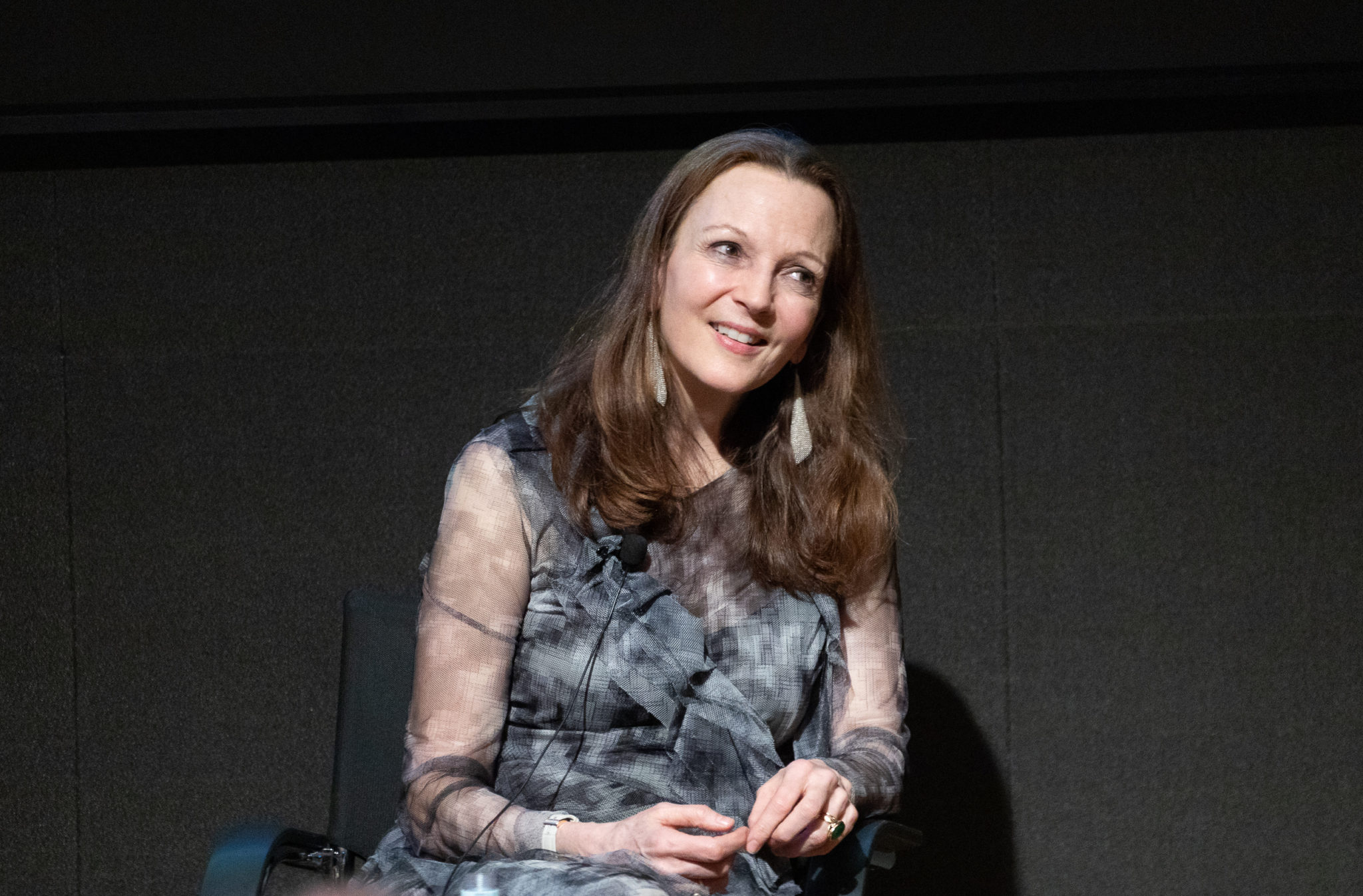Curator and coordinator. Lives and Works in Tokyo. Having worked as an assistant curator of Mori Art Museum, Tokyo (2001-9), she then moved to New Delhi India between 2009-18. While in India, she coordinated and researched for numerous projects. Worked as a project coordinator of Japan Foundation’s “Omnilogue: Journey to the West” at Lalit Kala Akademi, New Delhi in 2012, a research curator of Indian art for the Fukuoka Asian Art Triennale 2014, and coordinated to create a new video and painting installation of “The Returns of K.T.O.” by Japanese artist Tsuyoshi Ozawa for Yokohama Triennale 2017. Recent coordination is “Eiko Ishioka – Blood, Sweat , and Tears – A Life of Design ” at the Museum of Contemporary Art, Tokyo.
photo by Ujin Matsuo
Japan Contemporary Art Summit 2019
“Trans/National: Narrative of Contemporary Art after Globalization”
Open Keynote Lecture (1)
“Japanese Art in America: Reflections on my Life’s Work as Curator, Scholar and Activist.”
Alexandra Munroe Samsung Senior Curator, Asian Art and Senior Advisor, Global Arts, Solomon R. Guggenheim Museum
Japan Contemporary Art Summit is part of the Art Platform Japan project initiated by the Agency for Cultural Affairs (Bunkacho). Launched in 2018 as a five-year project, the Summit aims to enhance the presence and understanding of a recent passive recognition of Japanese contemporary art globally. The first Summit invited national and international art professionals, such as curators, researchers and archivists, to develop an international network to promote international joint research for the near future.
Japan Contemporary Art Summit 2019 discussed the topic, “Trans/National: Narratives of Contemporary Art after Globalization”. During the Summit, two renowned curators, Alexandra Munroe from America and David Elliot from the United Kingdom, gave keynote lectures that were open to the public. Both have organized historically important modern and contemporary Japanese art shows in the West from the mid-1980s onwards. The lectures re-visit how each curator analyzed and presented Japanese art to local audiences, and then explore possibilities to read and narrate contemporary global art of the late 20th and early 21st centuries.
Munroe received the Commissioner for Cultural Affairs Award of Japan this year. The award is bestowed by the Agency of Cultural Affairs on cultural practitioners who have contributed to the promotion of Japanese culture in Japan or abroad, advancing international cultural exchange. Her lecture opens with acknowledgements in Japanese, and the following remark: “When I began my research on postwar Japanese avant-garde art in the mid-1980s, I was virtually the only curator working in an American museum who believed in the importance and potential of this art historical subject. It was uncharted territory. But I held passionate conviction in the legitimacy of this history and the vitality of this new field, and believed that new perspectives would expand the ways we see and teach both Japanese art and international modern art studies.”
The key note lecture traces how she encountered Japanese culture, how she became a curator of Japanese art, and eventually, a museum leader in the field of global art history. Her passionate involvement in postwar Japanese art coincided with the expansion of Eurocentric perspectives on modern and contemporary art to encompass Asia and beyond. Her story invites us into the fascinating field of global art history.
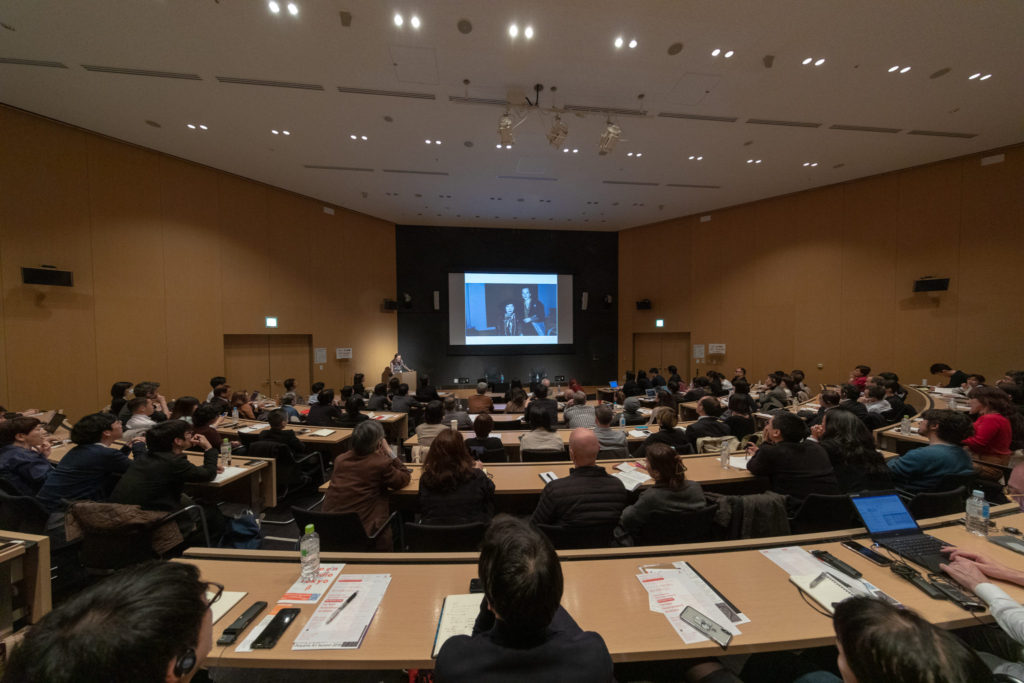
photo by Ujin Matsuo
1. Encounter with Japanese Culture
Munroe grew up in Ashiya, Japan, where the Gutai Art Association, a Japanese post-war avant-garde group, was born. Her parents became friends with leading expatriate intellectuals who were dedicated to introducing Japanese culture to America. One of them was Donald Richie, who brought postwar Japanese film to international prominence. The other was the publisher and translator Meredith Weatherby, who helped introduce modern Japanese literature to the world through his translation of Mishima Yukio’s novels.
While at Brown University, Munroe joined an exchange program at Doshisha University, Kyoto, and later studied at Sophia University, Tokyo. In Kyoto she was a lay disciple for three years at the Yotokuin sub-temple of Daitokuji, practiced zazen in the Rinzai tradition, and formally practiced Urasenke tea and Noh dance, or shimai, in the Kanze-ryu tradition. .
This experience and knowledge of Japanese history, culture and aesthetics have shaped her research in profound ways. Having said that what she acquired is a difficult pedagogy to emulate or codify, Munroe always urges younger academics and curators who are entering the field of modern Asian art to study classical art and philosophy as well as modern international art and critical discourse.
From the beginning of her career, Munroe has been very clear about her goal to change American institutions and educate their publics. She adds that such activism is no longer required today, but it was necessary for earlier generations. Calling herself a “cultural agent” between Japan and the US, Munroe pioneered the field of modern and contemporary Japanese art.
2. Asia as Method
Munroe states, “For most of the twentieth century, modernism was seen as a set of styles exported from the center to the periphery; non-Western modernism was regarded, if at all, as a mere ‘translation’.”
Since the beginning of her own studies, she says, geopolitical and theoretical shifts have facilitated new ways of mapping and interpreting modern art history and contemporary cultural practice, connecting geographically scattered movements and discourses through a model that the anthropologist Arjun Appadurai refers to as ‘transnationalism’.i According to his theory, modern societies are defined less by the fixed identities of nation-states than by the dynamic intercultural flows between peoples of different nationalities. This generous, messy, unpredictable phenomenon is what Appadurai calls ‘modernity at large’.ii
In the case of East Asia, Munroe analyzes that “artists have long mined their local and regional cultures while intersecting with, coproducing and stimulating artistic developments beyond their national borders.” She also points out that Japanese artists and intellectuals have, from the onset of ‘Westernization,’ resisted the conversion to modernist ideologies as dictated exclusively by the West.
In 1960, the Japanese thinker Takeuchi Yoshimi gave a lecture titled ‘Asia as Method’ in Tokyo. He compared the modernization of Meiji-era Japan, which evolved from 1868 in direct response to the West, and based its development on ‘simple binary oppositions’, to China’s modernization resulting from internal chaos and revolution. Takeuchi believed that, “If the goal of Asian modernization is to achieve global equality, it must universalize its cultural values,” which he called ‘Asia as method’.iii”
Munroe has adopted Takeuchi’s “Asia as method” theory, and “sought to apply it to [her] studies of Japanese, Chinese, and Korean art in a global context”.
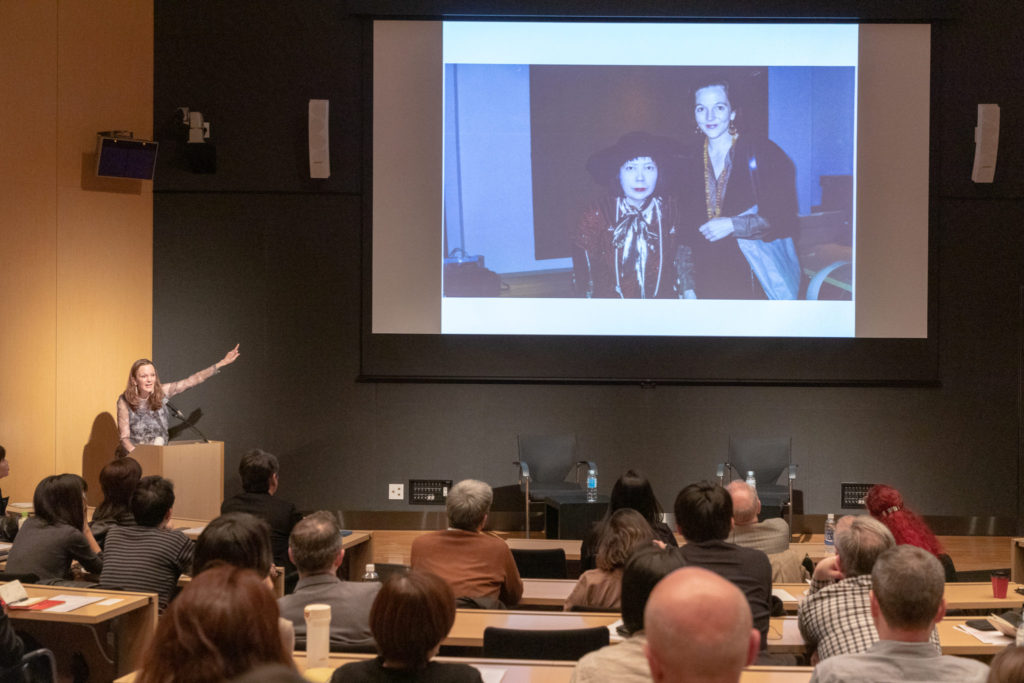
photo by Ujin Matsuo
3. Encounters with Japanese Avant-garde in New York
Munroe then talks how she came across Japanese avant-garde in New York. After having studied in Japan, Munroe arrived in New York in 1982, to assume a curatorial position under Director Rand Castile at the Japan Society Gallery in New York. The Japan Society is the leading center for Japanese arts, public policy, and education in America.
Her first project was a one-person exhibition of Shinohara Ushio, a contemporary Japanese artist based in New York. The show was called “Tokyo Bazooka.”
Shinohara entered Tokyo University of the Arts in 1952, and studied oil painting. By 1960, he became the most notorious member of Japan’s radical Neo-Dada Organizers. On Munroe’s first visit to his studio, Shinohara told her how the colorful wrappers of candy that the American G.I.s had given him were like a magic carpet to another world. Munroe points out that “the American flag, Duchamp’s chess board, Rauschenberg’s “Coca-Cola Plan” – all images he appropriated in his assemblages in the early 1960s defied the cultural void left by Japan’s defeat,” and in New York she discovered that “this psychological freedom from tradition, which Isozaki Arata has called the ‘death of history,’ helped generate a truly remarkable avant-garde culture in postwar Japan.”
Munroe was inspired to devote her curatorial and academic efforts to studies of Japan’s postwar avant-garde, and position its history in the broader context of international modernism.
However, she had to cultivate this new field from a scratch. When she entered graduate school at New York University’s Institute of Fine Arts in 1985, there existed virtually no English bibliography on her chosen topic of postwar Japanese avant-garde. Her research proposal was “heretical” to the Western academy of both Japanese art and modern art history departments.
In spite of challenges, Munroe remained true to her convictions and continued to challenge the Eurocentric biases of the Western academy. In 1989, she organized the first retrospective exhibition of Kusama Yayoi ever – in Japan or abroad – at the Center for International Contemporary Arts (CICA) in New York. It was a sensation, and prompted the reconsideration of Kusama’s contributions to the history of postwar avant-garde art in Europe, America and Japan. She presented Kusama’s “Infinity Net” paintings in the context of what artist and critic Donald Judd called Minimalism, and her “Accumulation Sculpture” in the context of what critic Lucy Lippard called Eccentric Abstraction. She also highlighted Kusama’s role in the historic “Zero” show at the Stedelijk Museum in Amsterdam in 1965. She presented her “happenings” in the context of American protest art and feminism while distilling their interpretation through the artist’s own unique psychological lens of what Kusama calls “Obsessional art.”
There, Munroe met the scholar and researcher Tomii Reiko. Since the Kusama show, they have worked together on many projects. As partners in a new field, they saw that “new and interdisciplinary approaches, perhaps a new area of study altogether, are needed to establish modern and contemporary Japanese art as a serious, international subject of scholarship and critical inquiry.”
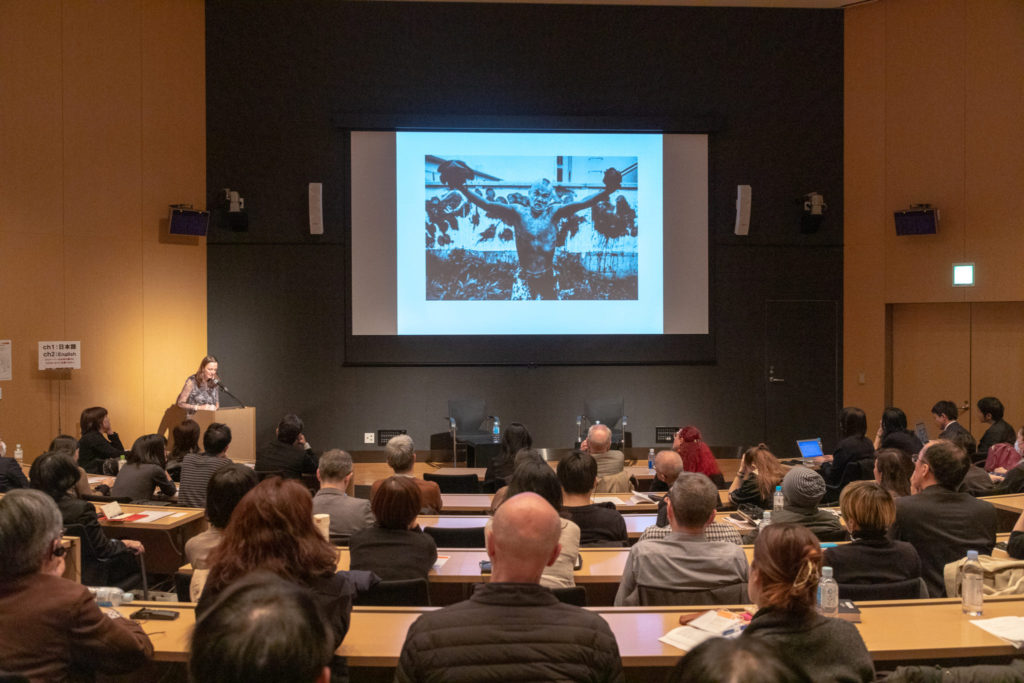
photo by Ujin Matsuo
4. Japanese Art After 1945: Scream Against the Sky
Soon after the Kusama show came a great turning point for Munroe. The newly opened Yokohama Museum of Art invited her to curate an exhibition of Japanese art. Thanks to the vision and dedication of museum curator Amano Taro, this project became the landmark show, and scholarly catalogue “Japanese Art After 1945: Scream Against the Sky.” It opened at Yokohama in 1994, and toured the Guggenheim Museum and San Francisco Museum of Modern Art through 1995.
The show traced the evolution and radical experimentation of self-professed avant-garde artists from circa 1952 to 1989, through the presentation of some 200 works by 100 artists including paintings, sculptures, performances, videos, photographs, experimental films and installations.
Munroe recalls, “Unlike earlier surveys of Japanese art presented in Japan until that time,
the show was unusual in many respects.”
Firstly, the show was not organized around a specific medium, decade or group. It focused on a deliberate intellectual, political and aesthetic lineage of opposition (hantaisei). Munroe argues that this opposition was associated with the rise of postwar leftist movements including Ampo (Japan-US Security Treaty), the 1968 student movements, the anti-Expo movements of the late 60s and early 70s, and the anti-emperor system movements of the 1980s. In this context, Munroe presented artsist and movements related to the Yomiuri Andepandan (Yomiuri Independent) including Neo-Dada Organizers, Hi Red Center and Kyushu-ha (Group Kyushu). Munroe points out that “artists deeply resisted the blind assimilation of Western culture, and equally, revolted against the academic orthodoxy of modern art in Japan.”
Secondly, the show tore down the boundaries of mediums, and incorporated works by artists experimenting with ceramic and ink, photography and experimental film, none of which had been featured in museum presentations of this period in Japan before. For example, the section called “Tradition and Modernism” featured key artists working for the Bokujinkai association of contemporary calligraphers, the avant-garde ceramic group Sodeisha, and interlocutors like artist Noguchi Isamu and calligrapher/painter Hasegawa Saburo, among others.
Thirdly, the show also incorporated Korean-born artists such as Nam June Paik and Lee Ufan, and such long expatriated artists such as Yoko Ono and Arakawa Shusaku, into a dynamic narrative of postwar art that intersected with sweeping international trends.
Above all, the show opened with Zero Jigen (Zero Dimension) and Gutai Art Association, focusing on early conceptualist works of Kanayama Akira, Tanaka Atsuko, Shiraga Kazuo and Murakami Saburo, as well as post-abstract painting experiments through the Sky Festival collaboration with French Informel critic Michel Tapié.
From the inception of her Yokohama project, Munroe was committed to tour the show to the US, since her main audience in mind was the Western art establishment. She says, “If we had opened the show (in the West) with the more canonical Surrealist or Reportage social realist school paintings, the works would have been criticized for being derivative, and the show would have failed.”
There was also a section focusing on conceptual art, beginning with Jikken Kobo (Experimental Workshop) and Tokyo Fluxus, and also incorporating works of Group Ongaku (Group Music), experimental film and video. Other sections presented Mono-ha, the work and thought, of Lee Ufan, Suga Kishio, and Koshimizu Susumu, and such PostMono-ha artists as Endo Toshikatsu and Kawamata Tadashi.
In 1995, when the show opened at the Guggenheim, the leading New York Times art critic wrote this review of America’s first show of postwar Japanese art:
“Scream Against the Sky raises at least as many questions as it answers, but it confirms beyond doubt that any reading of contemporary Japanese art in purely Western terms will not do. ”
Over time, Munroe’s “intention to introduce the extraordinary achievements of the postwar Japanese avant-garde had a lasting impact on the American academy and museum establishment.” The schaolrly book has become a textbook, and its theoretical framework has become a model as to how to study and think about modern and contemporary art from outside the West.
The exhibition had a great impact on the history of art in the West, while Munroe admits that the last section, dedicated to the 1980s and early 1990s, was the most problematic in the show. It should have remained a historical show, possibly ending around the 1980s, since the 1990s were still too young at that time. She hopes to be given a more vigorous platform someday to debate the legacy of this show in Japan.
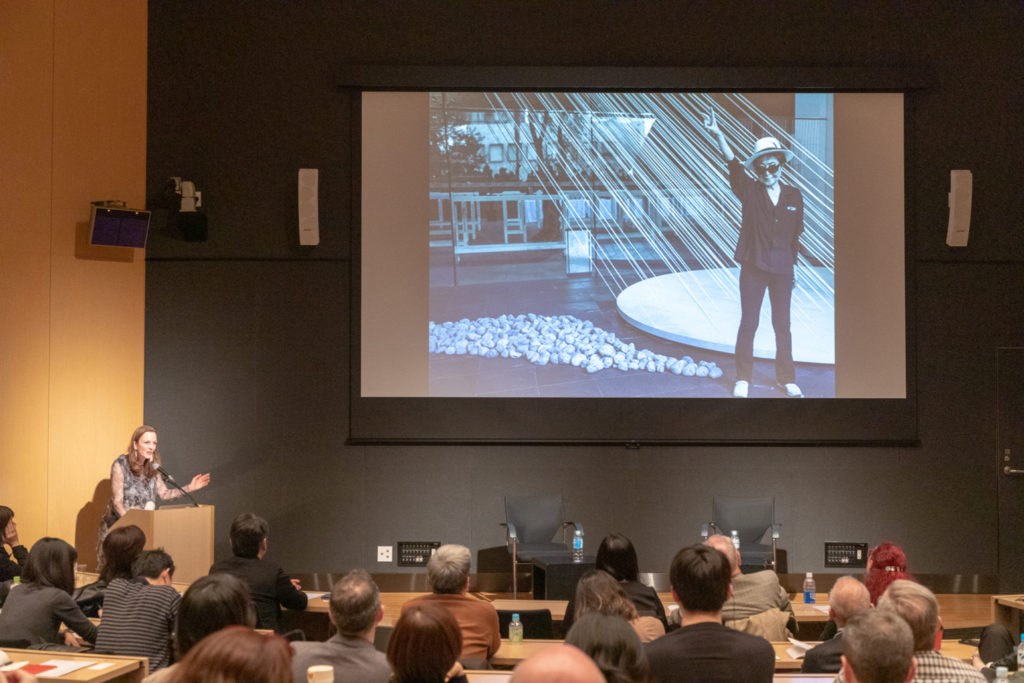
photo by Ujin Matsuo
5. Toward Asian Art in the 21st Century
In 1998, Munroe became director of the Japan Society Gallery. One of the first shows she organized was “YES YOKO ONO.” Yoko Ono’s partner John Lennon often said about her that she was “the world’s most famous unknown artist.” Munroe was convinced that “the time has come to establish her seminal importance as a major artist in her own right.” The exhibition positioned Ono in the Dadaist debate on art and life that was championed in New York during the 1950s by Marcel Duchamp and John Cage, and that aimed to break down the boundaries between high art and everyday life.
While director at the Japan Society Gallery, Munroe continued to organize exhibitions of classical Japanese art through a radically contemporary lens, and other Japanese solo shows, including the first retrospective exhibitions of photographers Moriyama Daido and Tomatsu Shomei in the US. For “Little Boy” (2005), she invited artist Murakami Takashi to curate an overview of the subculture of contemporary Japan.
In 2006, Munroe moved to the Guggenheim, which became the first modern and contemporary art museum in the West to establish a curatorial position dedicated to Asian art. Today the museum has four full-time curators specialized in Asian art in a global context. Munroe has also convened the Asian Art Council, a think-tank of rotating artists, academics, thinkers and curators who operate at the cutting-edge of thinking through new frameworks for the research and presentation of global art history.
Seeing how that engagement has influenced and inspired other museums to enter and act in modern and contemporary Asian art, Munroe expresses the shift as follows. “Through our ongoing efforts, we have changed the DNA of the Guggenheim and by example and influence, the DNA of other major museums presenting the story of modern art.”
6. Conclusion: Global Contemporary Art
Munroe argues that the term “global” has lost its radical quality as a critique of Euro- American hegemony in the arts. She then questions, “In the wake of globalization’s evident failures and the rise of new nation-centered, identity-driven, and anti-global resistance movements, what follows, and how can we engage with scholars, intellectuals, and artists from Asia to recalibrate and regenerate our cultural positions? As cultural practitioners, what new critical philosophies can we use to shape and make sense of the future?” Although many questions for the future are surrounding us today, Munroe believes that, “Within our globalized societies, like it or not, innovative artistic expressions of identity, resistance and difference are robust.” Reflecting on her wide travels and various activities in global art, Munroe ends her lecture by sharing her expectations toward future. “As always, I look to Japan for what will come next.”
The lecture traces how Munroe as a cultural bridge builder has challenged entrenched Western practices and perspectives in the field of modern and contemporary art history. Through her continuous curatorial and academic efforts, new interdisciplinary approaches, including discursive frameworks like de-centered modernism, have at last became mainstream in American museums and university programs.
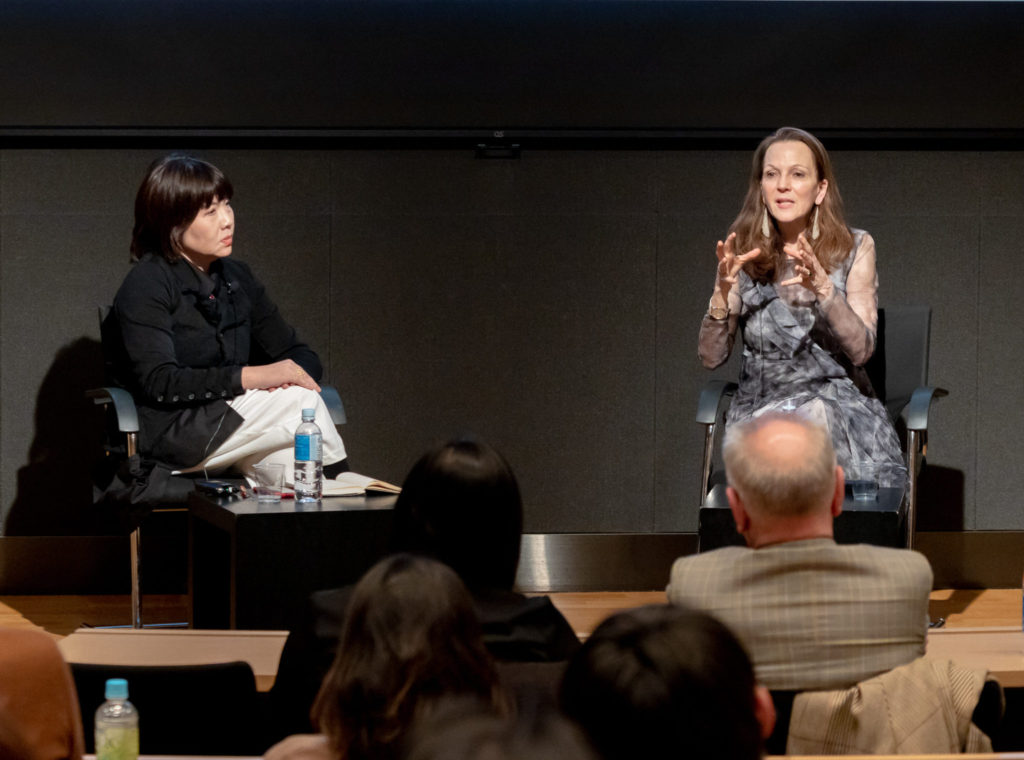
photo by Ujin Matsuo
i For discussions on transnationalism, see these seminal texts: Arjun Appadurai, Modernity at Large: Cultural Dimensions of Globalization (Minneapolis: University of Minnesota Press, 1996); Arjun Appadurai, Globalization (Durham, N.C.: Duke University Press, 2000); Homi K. Bhaba, ‘Locations of Culture,’ in The Transnational Studies Reader: Intersections and Innovations, ed. Sanjeev Khafram and Peggy Levitt (New York: Routledge, 2008); Andreas Huyssen, ed. Modernism after Postmodernity, New German Critique, 99 (Fall 2006); and Andreas Huyssen, ‘Geographies of Modernism in a Globalizing World,’ New German Critique 34, 1 (Winter 2007).
ii See Appadurai, Modernity at Large.
iii Takeuchi Yoshimi, ‘Asia as Method,’ What is Modernity? Writings of Takeuchi Yoshimi, trans. and ed. Richard F. Calichman (New York: Columbia University Press, 2005), pp. 149–65.
Bibliography:
Alexandra Munroe, “Obsession, Fantasy and Outrage: The Art of Yayoi Kusama” in Yayoi Kusama: A Retrospective (New York: Center for International Contemporary Art, 1989).
Alexandra Munroe, Japanese Art after 1945: Scream Against the Sky (New York: Harry N. Abrams, 1995).
Alexandra Munroe with Jon Hendricks, “YES YOKO ONO” (New York: Harry N. Abrams and Japan Society, 2000).
Alexandra Munroe, “Introducing Little Boy” in Little Boy: The Arts of Japan’s Exploding Subcultures, edited by Takashi Murakami (New York: New York: Harry N. Abrams and Japan Society, 2005).
Alexandra Munroe, Lee Ufan: Marking Infinity (New York: Guggenheim Publications, 2011).
Ming Tiampo and Alexandra Munroe, Gutai; Splendid Playground (New York: Guggenheim Publications, 2013).
Alexandra Munroe,
Ph.D., is a curator, scholar and writer on Asian art and a leader of global arts strategy for museums. Internationally recognized as among the most influential curators of her generation, she has organized the first U.S. retrospectives of Asian-born artists Yayoi Kusama (1989), Yoko Ono (2001), Cai Guo-Qiang (2008), and Lee Ufan (2011). Her 1994-95 survey exhibition, Japanese Art After 1945: Scream Against the Sky, is recognized for initiating the academic and curatorial field of postwar Japanese art history in North America. She is the lead curator for Art and China after 1989: Theater of the World (2017–18, co-organized with Philip Tinari and Hou Hanru). An authority on modern and contemporary Asian art and transnational art studies, Munroe is Samsung Senior Curator, Asian Art, and Senior Advisor, Global Arts, at the Solomon R. Guggenheim Museum, New York, positions created for her since she joined the museum in 2006. Under her leadership, the Guggenheim has expanded its mission to broadening the geographical scope of its programs through the study, acquisition, and exhibition of art from non-western regions. At the Guggenheim, Munroe serves on the Guggenheim Abu Dhabi’s Curatorial Working Group, which devises and implements the collections programs for the future museum. She also founded and presides over the Guggenheim’s Asian Art Council, a curatorial think tank. Munroe has won numerous awards including four prizes for best-show from the International Association of Art Critics (AICA), The Japan Foundation Awards 2017, Commissioner for Cultural Affairs Awards 2018.
INFORMATION
Bunkacho Art Platform Japan Bunkacho Art Platform Japan
Japan Contemporary Art Summit 2019
Trans/National: Narrating Contemporary Art after Globalization
Open Keynote Lecture (1)
Lecture by Alexandra Munroe(Samsung Senior Curator, Asian Art and Senior Advisor, Global Arts, Solomon R. Guggenheim Museum, and Interim Director, Curatorial Affairs, Guggenheim Abu Dhabi Project)
Moderator: Mami Kataoka (Deputy Director and Chief Curator, Mori Art Museum)
Date: March 19, 2019
Venue: Roppongi Academyhills
Organized: Agency for Cultural Affairs, Japan (Bunkacho)
Cooperation: Mori Art Museum


